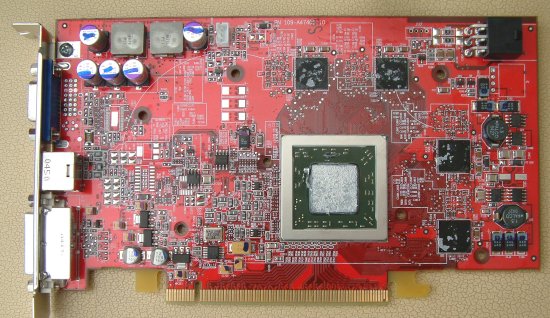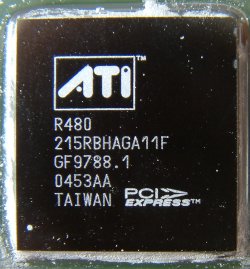Apperance and musings
Trotting out a table to delineate the differences between select ATI SKUs.| GPU | Radeon X800 GTO² | Radeon X800 GT | Radeon X800 GTO | Radeon X800 XL | Radeon X850 Pro | Radeon X850 XT | Radeon X850 XT PE |
| Codename/core | R480 | R4xx | R4xx | R430 | R480 | R480 | R480 |
| Manufacturing process | 130nm low-k | 110nm/130nm* | 110nm/130nm* | 110nm | 130nm low-k | 130nm low-k | 130nm low-k |
| Native Interface | PCI-Express | PCI-Express | PCI-Express | PCI-Express | PCI-Express | PCI-Express | PCI-Express | Core speed | 400MHz | 475MHz | 400MHz | 400MHz | 520MHz | 520MHz | 540MHz | Rendering pipelines | 12* | 8 | 12 | 16 | 12 | 16 | 16 | Memory buffer | 256MB | 128MB/256MB | 128MB/256MB | 256MB/512MB | 256MB | 256MB | 256MB | Memory speed | 980MHz | 700/980MHz | 700/980MHz | 980/980MHz | 1080MHz | 1080MHz | 1180MHz | Memory interface | 256-bit | 256-bit | 256-bit | 256-bit | 256-bit | 256-bit | 256-bit | Vertex shaders | 6 | 6 | 6 | 6 | 6 | 6 | 6 | Cheapest online price | £150 | £90/£110 | £110/£125-£140 | £185/265 | £210 | £230 | £260 |
Take a look at the SAPPHIRE X800 GTO² and then take another look at the basic features of a regular X800 GTO. Notice any difference that's not related to price? The 'GTO 256MB and 'GTO² both run with a default three-quad rendering setup, have core and memory clock speeds of 400MHz/980MHz, respectively, and, ceteris paribus, will benchmark the same. So what's the point of shelling out an extra £20-£25 above a GTO 256MB's price for this SAPPHIRE-exclusive X800 GTO²? The first indication of why it's potentially better lies with the GTO²'s rendering setup, and you'll see that we've asterisked it. Taking a physical look at the card will also help, so let's head on over there.

It's immediately clear that the X800 GTO² 256MB card conforms with the PCB design and general layout of ATI's high-end cards. The cooler is identical to that found on a reference Radeon X850 Pro. Head over here to see it directly above an ATI Radeon X850 XT PE. Take away the differences in the coolers and you're left with virtually identical layouts. The X850 XT is still a high-performance, four-quad card. See where we're going with this?

Following on from that, the GTO², unlike the GT/GTO incarnations, requires an auxillary 6-pin power connection to function correctly. It's clear that the GPU and PCB were designed with X850-class of cards in mind.

The rear of the card is pretty generic. There's a single-link DVI-I connector on the right. The S-Video socket is merely for TV-Out, and the VGA connector allows you to connect up to two displays concurrently. Shame there's not another killer feature such as dual DVI, or, for that matter, a dual-link DVI interface.

The back, too, is reminiscent of ATI's high-end SKUs. As mentioned, there's no VIVO compatibility on this particular model.
Taking away the single-slot cooler, whos fan can be controlled via SAPPHIRE's TriXX software, reveals the bare card.

SAPPHIRE also adds to the evidence that the Radeon X800 GTO² has X850-class origins by using 256MB of Samsung's delicious 1.6ns-rated DRAM devices. That's well above specification for the card's 980MHz default memory speed.

Removing the copious amounts of TIM shows us that the GTO² is powered by ATI's R480 core. The evidence of exactly what the SAPPHIRE Radeon X800 GTO² 256MB card is all about has been slowly building up. The X850-series' heritage is hard to ignore. So whilst all retail cards will ship with a 12-pipeline rendering setup, we have it on excellent authority that all GTO²s (not GT/GTOs, however) can be flashed with an easy-to-find BIOS that will activate the dormant fourth quad and turn it into a fully-fledged 16-pipeline ATI Radeon X800 card that runs at default X800 XL clocks. Indeed, you can find a guide highlighting just this fact right over here.
What's more, the use of R480 cores means that a 16-pipe GTO² may well overclock to ATI Radeon X850 XT/XT PE levels. Think of it as a 2-minute job that can potentially save you £100+ right now, giving you an X850 card on the cheap. This is precisely what makes the SAPPHIRE Radeon X800 GTO² an attractive proposition at around the £150 mark. A word of warning, flashing the card with a non-approved BIOS invalidates the card's 2-year warranty, but you can, of course, flash back if everything hasn't already gone Pete Tong.

An R480-based GPU with 16 active pipelines and default clocks of 400MHz/980MHz can only be a flashed Radeon X800 GTO². Due to time constraints, SAPPHIRE shipped us just its GTO² card. We've been informed that the retail bundle will be very similar to the GTO version's. You can find the associated box art here.
In a nutshell, then, the SAPPHIRE X800 GTO², an exclusive SKU, ships with the basic performance of the company's £20 cheaper Radeon X800 GTO 256MB card. However, the GTO² is basically a Radeon X850 XT/XT PE in disguise, evidenced by its physical apperance. Enabling the remaining rendering quad is a simple matter of flashing the card with an appropriate BIOS, pushing up the complement to a full X850-class' 16 pipelines. Further, the use of an R480 core dictates that GTO²s should overclock well, hopefully to X850 XT levels as a minimum. In due course you'll be able to run the X800 GTO² in a CrossFire setup, too.









